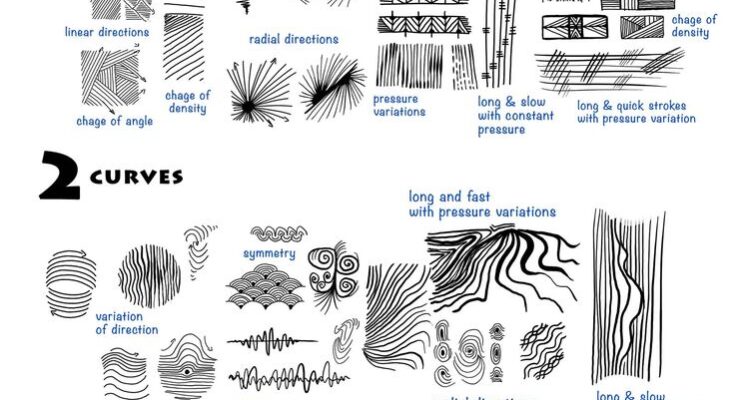Mastering the Art of Lines and Curves: A Beginner’s Guide to Repetition and Variation
Embarking on a creative journey often begins with the simplest elements—lines and curves. This comprehensive guide, illustrated with an array of engaging sketches, invites artists of all levels to explore the foundational techniques of repetition and variation. Whether you’re a budding illustrator, a seasoned designer, or simply seeking a mindful creative outlet, this detailed breakdown will inspire you to experiment with size, movement, pressure, and density to unlock your artistic potential.

Getting Started with Lines
The journey starts with lines, the building blocks of any drawing. The sketches under “1 Lines” showcase a variety of approaches to enhance your line work:
- Linear Directions: Explore straight lines with changes in angle and density, creating dynamic patterns that guide the viewer’s eye across the page.
- Radial Directions: Experiment with lines radiating from a central point, offering a sense of movement and energy, from short and slow strokes to more complex arrangements.
- Pressure Variations: Practice applying varying pressure to create depth, with examples ranging from consistent pressure to long, slow strokes and quick strokes with pressure shifts.
- Change of Density: Observe how clustering lines closely or spacing them apart alters the visual weight, adding texture and interest to your work.
Exploring Curves
Moving to “2 Curves,” the guide shifts focus to the fluidity of curved lines, each sketch revealing unique techniques:
- Variation of Direction: Play with the flow of curves, from gentle waves to sharp turns, to build rhythm and harmony in your designs.
- Attenuation: Discover how curves can taper or widen, adding a sense of progression or emphasis, as seen in the undulating patterns.
- Symmetry: Create balanced compositions with mirrored curves, enhancing the aesthetic appeal with symmetrical elegance.
- Radial Directions: Extend curves outward from a center, with long and fast strokes featuring pressure variations for a bold effect.
- Long & Slow with Less Pressure Variations: Master smooth, flowing curves with minimal pressure changes, ideal for delicate, organic forms.
Diving into Waves and Spirals
The section “3 Waves, Spirals” elevates the practice with more complex forms:
- Change of Direction: Craft waves that shift direction, creating a sense of motion and depth, as seen in the layered wave patterns.
- Variation of Density: Adjust the density of waves and spirals, from tight clusters to sparse arrangements, to control the visual impact.
- Variation of Density with Pressure Variations: Combine density with pressure changes to add dimension, as illustrated in the textured spiral sketches.
- Symmetry: Develop symmetrical spiral designs that radiate balance and harmony, perfect for intricate artwork.
- Variation of Size: Experiment with scaling spirals from small to large, creating focal points or expansive backgrounds.
Practical Tips for Practice
This guide emphasizes four key elements to refine your technique:
- Size: Transition from small, intricate details to large, bold strokes to explore scale and proportion.
- Movement: Vary the speed of your hand, from slow, deliberate lines to fast, energetic sweeps, to capture different moods.
- Pressure: Adjust the pressure of your pencil or pen, from light touches to heavy marks, to add contrast and texture.
- Density: Play with the spacing of lines and curves, from dense clusters to rare, sparse arrangements, to influence the overall composition.
Posted on July 03, 2025, at 05:39 AM EDT, this tutorial encourages you to grab a sketchbook and pencil to practice these techniques. Start with simple repetitions, then introduce variations to see how each adjustment transforms your work. Whether you’re sketching for relaxation or building skills for a larger project, this foundation in lines and curves will set the stage for endless creative possibilities!



